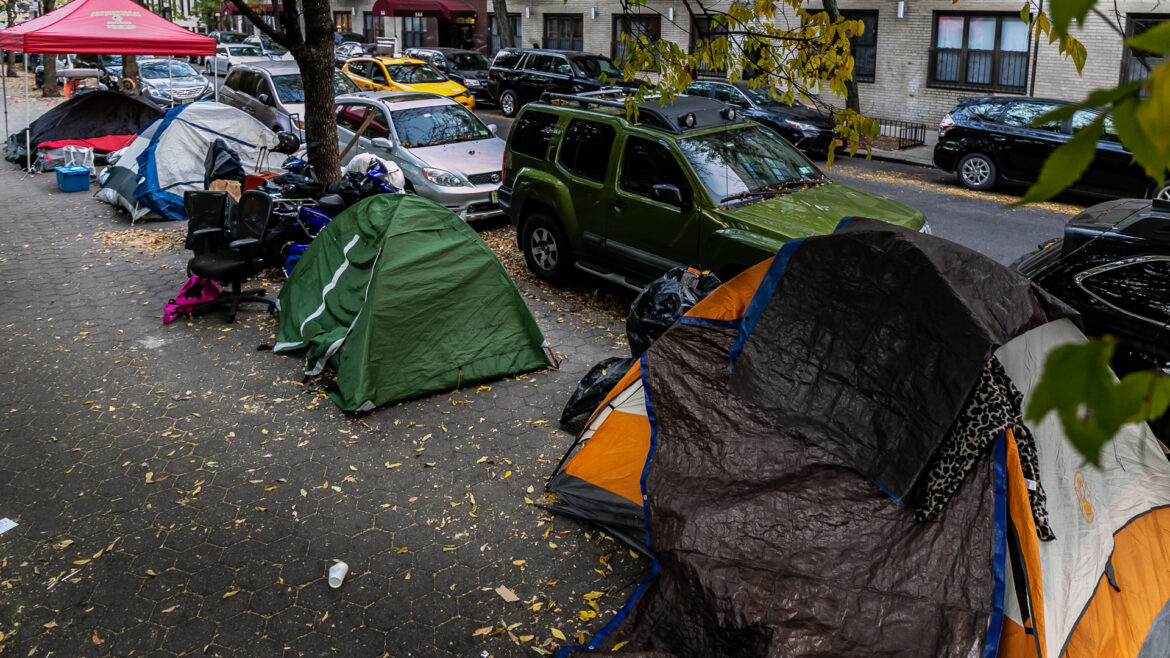The U.S. Department of Housing and Urban Development’s yearly nationwide census, based on data collected in January 2024, counted 771,480 people experiencing homelessness—up 18 percent from 2023.
The federal government’s latest assessment of homelessness across the U.S., which estimates the number of people experiencing homelessness on a single night nearly a year ago, is the highest ever recorded, according to a report released Friday by the U.S. Department of Housing and Urban Development.
The yearly census, based on data collected by hundreds of localities nationwide in January 2024, counted 771,480 people experiencing homelessness—up 18 percent from 2023, and up nearly 33 percent since the pandemic hit in 2020.
The count includes nearly 500,000 people staying in shelters or transitional housing, and another 274,224 who were unsheltered, or sleeping in places like sidewalks, transit stations, abandoned buildings or parked cars.
“Several factors likely contributed to this historically high number,” the report reads. “Our worsening national affordable housing crisis, rising inflation, stagnating wages among
middle- and lower-income households, and the persisting effects of systemic racism have stretched homelessness services systems to their limits.”
HUD
New York saw the largest increase in the number of people experiencing homelessness of any state, jumping 53 percent from 2023 to 2024, and was also among the states with the largest homeless population overall (158,019 people), second only to California (187,084 people).
The HUD report attributed both the spike in New York and several other municipalities, in part, to the number of new immigrants and asylum seekers who’ve crossed the border in recent years, many of them having entered shelter.
“In the 13 communities that reported being affected by migration, family homelessness more than doubled. Whereas in the remaining 373 communities, the rise in families experiencing homelessness was less than 8 [percent],” the report reads.
But in the nearly 12 months since the count was conducted, border crossings have dropped sharply, following increased immigration restrictions by the Biden administration starting in June. This month, New York City began closing 25 of its 199 emergency migrant shelters, citing steadily declining population numbers, though nearly 55,000 migrants and asylum seekers remain in the system, the majority of them families with children.
Compared to other household configurations, families with kids accounted for the steepest increase in HUD’s annual homelessness count, jumping 39 percent from 2023 to 2024.
Nearly all other populations included in the survey also reached record highs this year, according to the report. This includes individuals with chronic patterns of homelessness, people staying in unsheltered locations, people staying in sheltered locations, and unaccompanied youth.
The only group to see a decrease was veteran Americans, with 2,692 fewer experiencing homelessness in 2024 than in 2023, an 8 percent decline.
HUD
Roughly one in every five of the people included in the count were aged 55 or older. Nearly a third of those experiencing homelessness, or 32 percent, identified as Black or African American, despite making up just 12 percent of the country’s population overall.
“No American should face homelessness, and the Biden-Harris Administration is committed to ensuring every family has access to the affordable, safe, and quality housing they deserve,” said HUD Agency Head Adrianne Todman in a press release Friday.
The announcement pointed to changes in the housing landscape since the numbers were collected at the start of the year, including HUD’s creation of 435,000 new rental units and nationwide rent prices that have “stabilized significantly.”
“While this data is nearly a year old, and no longer reflects the situation we are seeing, it is critical that we focus on evidence-based efforts to prevent and end homelessness,” Todman said.
HUD pointed to several cities that have seen decreases in recent years. They include Dallas, Texas, which launched a $30 million “Street to Home Initiative” in 2021 to connect people living in “highly visible public spaces” with permanent housing. The city’s homeless population dropped by 16 percent since 2022, according to HUD.
The National Alliance to End Homelessness, a federal nonprofit, said the record-high numbers should “sound the alarm” for lawmakers at all levels of government.
“The answer to ending homelessness is ensuring everyone has access to safe, stable, and affordable housing,” said Ann Oliva, the group’s CEO. “Our leaders must immediately expand the resources to rehouse people without homes and assist the rapidly growing number of people who cannot afford skyrocketing rents.”
You can read the full HUD report below.
The post Federal Point-in-Time Homeless Count Was Highest on Record in 2024 appeared first on City Limits.

